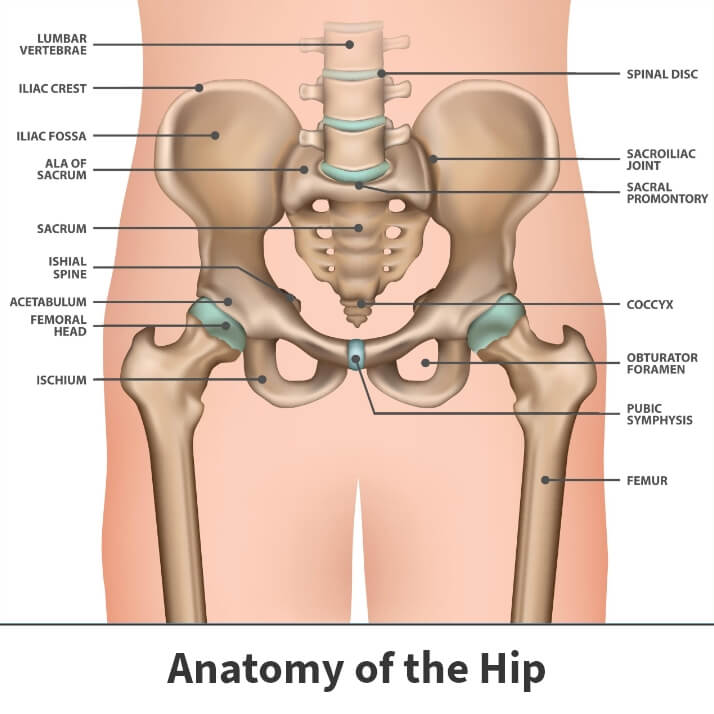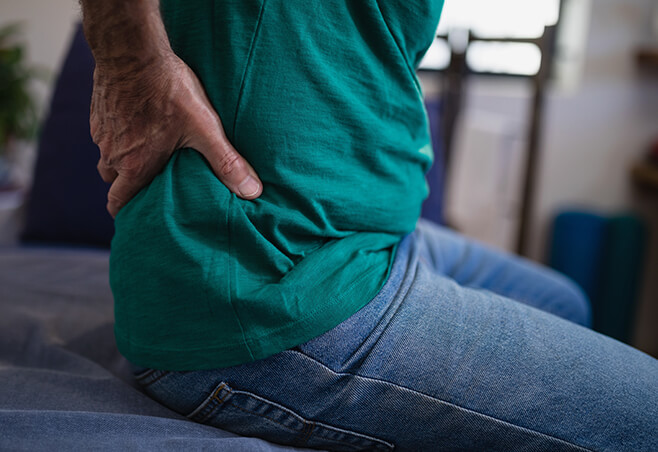Anterior hip replacement
Hip arthroplasty anterior approach
Surgeons use various approaches to access the joint during hip arthroplasty, and each differs by incision location, muscle impact, and recovery experience. An anterior hip replacement is performed through a small incision on the front part of the hip.
Total hip replacement utilizing the anterior approach is often referred to as minimally invasive or muscle-sparing because this type of surgery is performed without cutting any muscles. Instead, a surgeon works between the muscles, which helps patients recover more quickly and with less pain.
Anterior hip replacements are performed most commonly to address pain caused by different types of hip arthritis. Other reasons for getting a hip replacement include treating a broken or injured hip, a bone that has died because it did not get enough blood (avascular necrosis or osteonecrosis), or a bone tumor.
Keep reading to learn more about:
- What causes someone to need a hip replacement,
- Who is a good candidate for anterior hip replacement,
- How direct anterior hip surgery benefits patients,
- What happens during hip arthroplasty with an anterior approach and
- What to expect during this procedure’s recovery process.

Anatomy

The hip is a ball-and-socket joint. Its socket—formed by the acetabulum—is part of the large pelvis bone. The ball (or femoral head) is the upper end of the femur (thighbone).
The bone surfaces of the ball and socket are covered with articular cartilage, a smooth tissue that cushions the ends of the bones and enables them to move easily. A thin tissue called a synovial membrane surrounds the hip joint.
In a healthy hip, this membrane makes a small amount of fluid that lubricates the cartilage and eliminates almost all friction during hip movement. The hip joint also contains bands of tissue called ligaments that connect the ball to the socket and provide stability to the joint.
Reasons patients get anterior hip replacements
If your hip has been damaged by arthritis, a fracture, or other conditions, everyday activities such as walking or getting in and out of a chair may be painful and difficult. Your hip may be stiff, and it may be hard to put on your shoes and socks. You may even feel uncomfortable while resting.
According to the Agency for Healthcare Research and Quality, more than 450,000 total hip replacements are performed yearly in the United States. This safe and effective procedure can relieve pain, increase motion, and help people return to enjoying regular activities.
Patients typically talk to a surgeon about hip replacement with the anterior approach when medications, changes in everyday activities, walking support use, and other nonsurgical treatments are ineffective.
Who benefits from an anterior hip replacement procedure?
Total hip arthroplasty (THA) is an option for any patient needing a hip replacement, not just patients with an average body mass index (BMI) or who are active. This muscle-sparing approach can lead to a faster recovery with less pain and fewer movement restrictions, which makes it a good choice for those wanting to return quickly to daily activities.
Who should avoid anterior approach hip replacement surgery?
There aren’t any true contraindications or reasons to avoid total hip replacements with an anterior approach.
4 advantages of anterior hip replacement

Anterior hip replacement surgery offers several advantages, including:
- Less damage to major muscles
- Less post-operative pain
- Faster recovery
- Fewer post-surgical precautions
Less damage to major muscles
When performing an anterior total hip replacement, a surgeon doesn’t cut or detach any of the muscles to the hip but instead works between the natural spaces between them.
Less post-operative pain
By not cutting major muscles, there is less pain after surgery and less need for pain medication.
Faster recovery
Research shows that people with anterior hip replacements stop using walkers, canes, and other assistive devices sooner than traditional hip surgery patients.
Fewer post-surgical precautions
While the anterior approach to hip arthroplasty is an excellent choice for first-time hip replacements, revision (or re-do) surgeries may be limited by this technique. Additionally, patients with certain body types may be at a higher risk for wound complications with anterior total arthroplasty. Patients who have undergone an anterior hip replacement should also avoid sleeping in certain positions or with pillows between their legs.
That said, anterior approach patients can do some activities (such as crossing their legs or bending over immediately) which aren’t recommended for those who underwent hip arthroplasty using other approaches.
Watch Dr. Anthony F. Infante Jr. explain hip replacement options
Speak to a Florida Orthopaedic Institute surgeon about the potential advantages and disadvantages based on your specific circumstances, such as the type of hip arthritis, anatomy, overall health, and lifestyle.
What happens during anterior hip replacement
Most total hip replacements are done under spinal anesthesia. Patients are given shots in their backs that make their legs numb. In addition, they’re given medicine to help them disassociate while surgery is performed. With this method, patients breathe independently while their hips are being replaced. By avoiding the use of breathing tubes or anesthesia gases, they come out of surgery feeling much better and more alert.
Also, before the anterior hip replacement procedure begins, the skin around the surgical site is cleaned, and all hair is removed. Your surgeon will then cut in front of your hip joint and separate your muscles to see your hip joint.
Next, your surgeon removes the upper part of your femur and the damaged cartilage and bone from your pelvis. Then, the surgeon replaces the hip joint with an implant that consists of a metal socket and a new ball (which is anchored into the thigh bone).
Another advantage of the anterior approach is that surgeons can use X-rays during the procedure to confirm a patient’s implants are appropriately positioned and their legs are the same length.
Finally, the surgeon or an assistant closes the incision.
What’s new in the anterior hip replacement approach
Other innovative options besides the direct anterior approach are available to tailor an arthroplasty procedure to your needs.
Some of the hip replacement advances include the following, which aim to provide better surgical precision, faster recovery times, and better outcomes:
- Mako robot-assisted hip replacement: Using a patient-specific 3D model as a guide, surgeons can place artificial joints more precisely during hip arthroplasty. The Mako technology also streamlines removing the diseased bone (and preserving healthy bone).
- Computer-assisted (image-guided) hip replacement: This technology for hip arthroplasty incorporates digital imaging and navigation tools, which help surgeons enhance precision and improve overall implant placement accuracy.
- Cementless (press-fit) hip replacement: This method, used during hip arthroplasty, involves securing implants without bone cement, allowing natural bone growth to hold them in place.
- Outpatient (same-day) hip replacement: Patients who choose this option can avoid a hospital stay and return home on the same day as their surgery.
Why choose FOI for your anterior hip replacement
Florida Orthopaedic Institute’s hip specialists concentrate on reducing (and preventing) hip pain and restoring function. As recognized leaders in musculoskeletal care, our hip specialists combine world-class training, innovation, and individualized solutions to keep you active.
FOI’s surgical team includes some of the best hip specialists in the United States. Picking the right surgeon is essential for a successful anterior hip replacement. We’re here to support you with expertise, convenience, and comprehensive care.
When ready, contact us to schedule a consultation and discuss your options with a surgeon specializing in anterior hip replacement.

Anterior hip replacement FAQs
In an anterior hip replacement, a surgeon makes a small incision (commonly about four inches in length) on the front of your hip, usually starting at the top of your hip bone (pelvis) and extending down toward your upper thigh. Alternatively, they may use a “bikini incision,” a cut closer to the groin area along the natural crease where your leg meets your body.
Most patients go home the same day following anterior hip replacement surgery. They also typically begin therapy within hours of their operation. Anterior total hip arthroplasty patients can also walk—and even go up and down stairs—on the same day of their surgeries.
Learn more about physical therapy and its benefits after surgery
Timing varies from person to person, but anterior hip replacement recovery week by week looks like this.
Within 10 to 14 days, you’ll likely begin walking without a walking aid and start bathing or showering. By three to six weeks, you should be able to walk normally without crutches and might be capable of returning to light activities. Between four to eight weeks, you’ll typically be able to return to work, and most of the time, after eight weeks, you should be able to start walking for exercise.
For up to one year after surgery, it’s essential to continue personalized exercises for strength, stability, and balance.
Additionally, your artificial hip may wear out or loosen over time. Eventually, you might need another surgery to replace the parts. You can help extend the life of your implant by exercising regularly and taking precautions to avoid falls.
Also known as repeat hip replacements, hip revisions can be successfully performed with a direct anterior approach. In these procedures, surgeons repair or replace hip replacements due to instability, infection, fracture, or other complications.
After an anterior hip replacement, you should avoid excessive hip extension (like stepping too far backward) and external rotation of your hip to protect your new joint as it heals. While this approach typically has fewer restrictions than others, be sure to follow your surgeon’s specific advice on movements and activities to avoid during your recovery.
Videos
Related specialties
- Avascular Necrosis (Osteonecrosis)
- Groin Strains & Pulls
- Hamstring Injuries
- Hip Arthroplasty
- Hip Arthroscopy
- Hip Dislocation
- Hip Flexor Strains
- Hip Fractures
- Hip Hemiarthroplasty
- Hip Impingement Labral Tears
- Hip Muscle Strains
- Hip Pointers & Trochanteric Bursitis
- Iliopsoas Tenotomy
- Labral Tears of the Hip (Acetabular Labrum Tears)
- Osteoarthritis of the Hip
- Osteoporosis
- Pelvic Ring Fractures
- Piriformis Syndrome
- Sports Hernias (Athletic Pubalgia)
- Thigh Fractures
- Thigh Muscle Strains
